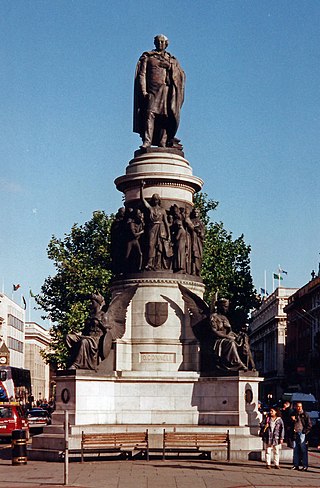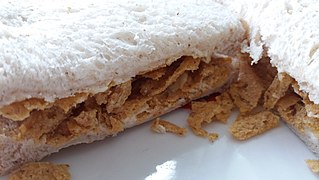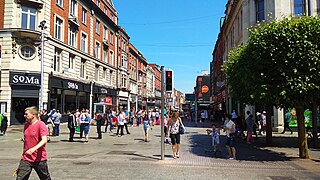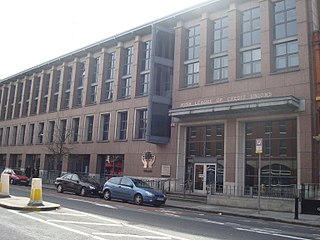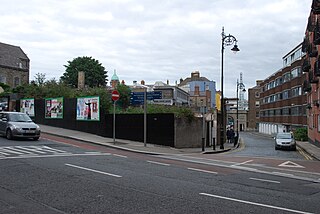Planning controversy
From 1996, Dublin City Council planned to demolish the terrace in order to redevelop the area, but this was opposed by groups who held this terrace and the battlefield trail running from the GPO down Moore Lane and Henry Street and into Moore Street to be an important part of Irish history, some referring to the location as "Ireland's Alamo". The National Graves Association began its campaign in 2002 after being alerted to the removal of a commemorative plaque from the facade of no. 16 by Patrick Cooney, which led to setting up the "Save 16 Moore Street committee" in 2005. Numbers 14-17 Moore Street were declared a national monument in 2007, guaranteeing their retention. [11]
However, plans for a €1.25 billion retail and residential scheme on nearby O'Connell Street, intended to be built by Joe O'Reilly (CE of the Chartered Land Group, which developed the Dundrum Town Centre), are controversial. At Easter Rising commemorations in April 2009, opponents of the scheme contended that it would involve major alterations to numbers 14-17 and pledged to challenge it at forthcoming public hearings. [12] [13]
Objectors, including families of the signatories of the Irish Proclamation of Independence, have pledged to seek an EU ruling to preserve the terrace if the developer's plan to subsume it and Moore Lane into the planned mall surrounding the GPO is waved through by the Irish Government. In November 2012, the legal representative for relatives of the 1916 leaders told the Joint Committee on the Environment, Transport, Culture and the Gaeltacht that Chartered Land accepted that it does not have the money to build the development due to the developer's debts. In the meantime, the interior and exterior of the houses have reportedly deteriorated badly. [14] In January 2013, a report by the Technical Group of Irish parliamentary representatives called for the Moore Street quarter to be saved and opposed the shopping mall plan. [15]
In August 2015, Chartered Land proposed to swap Nos.14-17 (which had a preservation order on them since 2007) for Nos. 24-25, which were owned by the local authority [16] distributed leaflets and lobbied elected Councillors. [17] Following strategic lobbying by the Save Moore Street Committee which included relatives of the 1916 executed leaders, the proposal was defeated by a large majority at a Dublin City Council meeting in November of that year. [18] In September of 2015, the State agency NAMA sold Chartered Land's property assets via auction to Hammerson (British) and Allianz (German). [19] However, in March 2015 it was announced in the media that the State had purchased Nos. 14-17 from Chartered Land for a total of €4 million, and would be preparing a museum there in preparation for the centenary commemorations of the Rising in the following year. [20]
In January 2016 the Save Moore Street Committee was monitoring the buildings on a daily basis and saw that demolition work was about to begin. Despite a continued campaign of trying to engage with the minister, legal action was triggered by campaigners. In tandem with the action the houses were occupied by protesters from a variety of political backgrounds and held for five days. [21] [22] [23]
A long-time Save Moore Street campaigner, Colm Moore, supported by the committee and 1916 relatives took a number of legal challenges on State decisions regarding the street to the High Court. Justice Max Barrett gave an interim order that no demolition take place until the case had been heard and the occupiers left the building. Subsequently, after hearing heavy machinery at work within the buildings and the refusal of the Minister of Heritage to permit independent inspection of the work, refusing access to a delegation of members of the Irish parliament and the Lord Mayor of Dublin, [24] activists of the Save Moore Street 2016 campaign group, which had arisen out of the occupation, blockaded the site and prevented building workers gaining access. The blockade was maintained for almost six weeks and was lifted only with the delivery of the Barrett judgement. On 18 March, having heard the case of Mr. Moore and the State's defence, Justice Barrett declared that not only the whole terrace but the surrounding street and lanes constituted a national historic 1916 Battleground. [25]
The Minister of Heritage, Heather Humphreys, with the support of the Government cabinet, lodged an appeal against this decision, the hearing of which was scheduled for late December 2017. [26]
The Save Moore Street 2016 campaign group has also organised a number of public events. [27] Campaigners and traders have claimed that the street market is being run down deliberately. [28]



